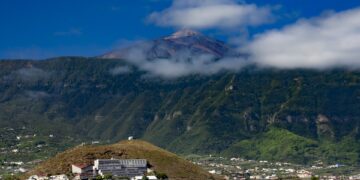The Cabildo of Tenerife’s president, Rosa Dávila, announced yesterday that “out of the 75 measures outlined in the decree declaring a water crisis, 90% are already in progress, meaning around 67 measures are currently being implemented by the Cabildo, Balten, and Insular Water Council” to tackle the severe drought affecting the island, especially the agricultural sector.
These statements were made by the island’s president prior to the inaugural meeting of the Drought Table, alongside the island’s vice president, Lope Afonso, the Minister of Natural Environment, Sustainability and Security and Emergencies, Blanca Pérez, and the Minister of Primary Sector, Valentín González.
During the Drought Table meeting, these statistics were presented along with the Cabildo’s target of providing “an additional 12,000 cubic meters of water starting from July with the emergency measures we have put in place”, with 80% of this allocation intended for the agricultural sector, equivalent to about 9,000 cubic meters.
Furthermore, it was mentioned that “the Tenerife Island Water Council aims to provide approximately 60,000 cubic meters in under a year”, resulting in a more than 10% increase in water supply for the general population and a 25% boost for the agricultural sector. This expansion will be made possible through collaborations with Balten, several municipalities, and private sector stakeholders who own underground installations and desalination plants.
Additionally, Dávila stated that “currently, no municipality faces water shortages, ensuring a steady water supply.”
Along with presenting this data, the Drought Table will produce “a comprehensive report on the 75 measures and provide monthly updates on their progress and the evolving water situation on the island during the summer and beyond,” as stated.
Moreover, the island’s president stressed the essential role played by local councils in raising awareness among residents and promoting the “rational” use of water, urging citizens to use potable water exclusively for human consumption and advocating for water conservation.
Meanwhile, Blanca Pérez outlined some of the ongoing actions discussed at the Roundtable, including a recent meeting with Endesa to expedite energy availability, the inauguration of a desalination plant in Isla Baja, and the enhanced capacity at Abona, providing 1,200 cubic meters, which “can aid in resolving the upcoming potato harvest in the region,” alongside water exchanges and a subsidy to the Funche irrigation community to secure 1,000 cubic meters, among other initiatives aimed at enhancing the quality of treated water in Acentejo and the Northeast Region.
The Minister also appealed to the public to utilize water responsibly, stating that “every drop counts.”
On the other hand, Valentín González highlighted the concerning state of the Tenerife reservoirs, noting that “the Balten reservoirs are at approximately 40% capacity, underscoring the importance of implementing measures to increase water flow, particularly in central areas.” “We are actively working on a system of exchanges to maintain flows in these regions and seek to interchange with treated or desalinated water in the lower sections of municipalities,” he elaborated.
Structure
The Drought Table serves as a collaborative body under the Tenerife Island Water Council, established to oversee and communicate the water crisis declaration.
It comprises representatives from local councils, consortia, public entities, service management companies, water users, agricultural associations, business and trade bodies, the Canary Islands Government, and the Cabildo. Additionally, each hydraulic region has a farmer representative as well as the directors of public company Balten and the Tenerife Island Water Council.
















